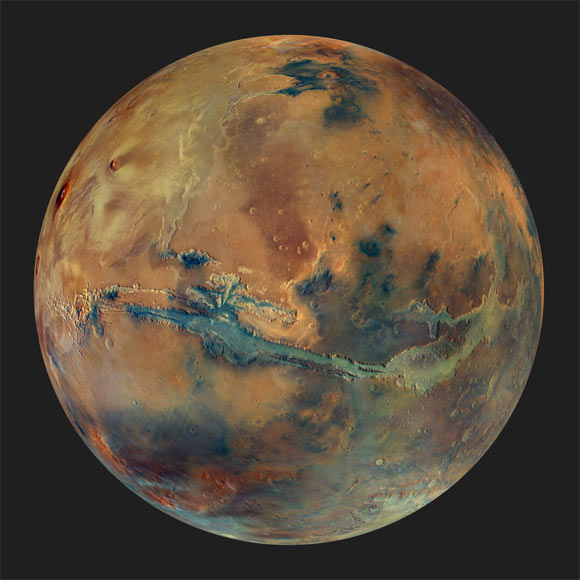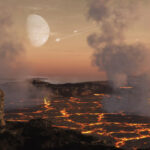On June 2, 2023, to celebrate the 20th birthday of ESA’s Mars Express, you’ll have the chance to get as close as it’s currently possible get to a live view from the Red Planet. Tune in to be amongst the first to see new pictures roughly every 50 seconds as they’re beamed down directly from the Visual Monitoring Camera on board Mars Express. One-hour livestream starts on the ESA YouTube channel 12:00 p.m. ET (18:00 CEST, 17:00 BST).
“Most observations and data gathered by spacecraft are taken during periods when they are not in direct contact with a ground station antenna on Earth,” members of the Mars Express team said in a statement.
“Either because of geometry or the spacecraft’s antenna is pointing away from Earth while gathering science data.”
“For science, this is no problem. The data is stored on board and beamed down a few hours or even days later, once the spacecraft is in contact with the ground again.”
What normally happens for Mars Express’ Visual Monitoring Camera, dubbed the Mars Webcam, is every couple of days a new batch are downlinked, processed and made available to the world.
“In fact, there are only a few examples in the history of spaceflight; including NASA’s DART and LCROSS missions which filmed the view as they intentionally crashed into asteroid Dimorphos and the Moon, respectively, and of course, the Apollo missions sent back spectacular live video that captured the globe, showing astronauts walking on the Moon’s surface,” they noted.
“These missions were all pretty close to home and others farther away sent perhaps an image or two in near real-time. When it comes to a lengthy livestream from deep space, this is a first.”
During today’s livestream, the time between the images being taken from orbit around Mars and appearing on your screen will be about 18 minutes.
That’s 17 minutes for light to travel from Mars to Earth in their current configuration, and about one minute to pass through the wires and servers on the ground.
The Visual Monitoring Camera is an old camera, originally planned for engineering purposes, at a distance of almost 3 million km from Earth — this hasn’t been tried before and to be honest, we’re not 100% certain it’ll work,” James Godfrey, spacecraft operations manager at ESA’s mission control centre.
“But I’m pretty optimistic. Normally, we see images from Mars and know that they were taken days before.”
“I’m excited to see Mars as it is now — as close to a Martian ‘now’ as we can possibly get!”
This image from Mars Express’ High Resolution Stereo Camera shows the globe of Mars set against a dark background. The disk of the planet features yellow, orange, blue and green patches, all with an overall muted grey hue, representing the varying composition of the surface. Image credit: ESA / DLR / FU Berlin / G. Michael / CC BY-SA 3.0 IGO.
To mark 20 years of Mars Express, the team also produced a spectacular composite image of Mars.
The mosaic was created using data from Mars Express’ High Resolution Stereo Camera (HRSC).
“HRSC normally photographs Mars’ surface from an altitude of about 300 km — the closest the spacecraft gets to Mars in its elliptical orbit — with the resulting images covering areas about 50 km across,” the researchers said.
However, the new mosaic uses a slightly different approach.
To view the planet more widely, HRSC gathered 90 images at higher altitudes (of 4,000 to 10,000 km), thus capturing areas of around 2,500 km wide. These images were then put together to form a full global view.
Thanks to its nine imaging channels, HRSC can visualize Mars not only in three dimensions but also in color.
However, the ever-changing opacity of the Martian atmosphere makes it difficult to determine accurate surface colors from orbit.
Dust scatters and reflects light, causing colors to shift between images and creating a patchwork-like effect when assembling a mosaic.
“While beautiful in its own right, the mosaic also provides fascinating information about Mars’ composition, revealing an unprecedented variety and detail of colors across its surface,” the scientists said.
“Mars is famous for its reddish color, which is caused by high levels of oxidized iron.”
“However, large parts of the planet appear to be rather dark and blue-toned here.”
“These are grey-black basaltic sands of volcanic origin that form far-reaching, dark layers of sand across Mars. They pile up as they move in the wind, creating imposing sand dunes and dune fields within impact craters.”
“Material weathered by water, on the other hand, tends to look lighter.”
The two most common water-weathered minerals on Mars, clay and sulfate minerals, appear particularly bright on such color composites.
The presence of these minerals signals that liquid water existed on Mars for a long time, weathering and altering rock over time to form significant clay deposits such as Mawrth Vallis.
“Sulfate minerals are visible here within the Valles Marineris canyon system, as seen most clearly in the annotated image,” the researchers said.
“Here, however, they are covered by a thin veneer of dark sand, but their impressive color variations can be seen on closer look.”
“Unlike clay deposits, sulfate minerals indicate more acidic environmental conditions that would be less friendly to life.”




